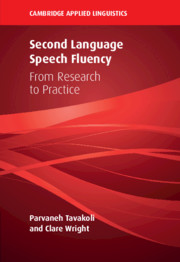Book contents
- Second Language Speech Fluency
- The Cambridge Applied Linguistics Series
- Second Language Speech Fluency
- Copyright page
- Dedication
- Contents
- Figures
- Tables
- 1 Introduction
- 2 Fluency from a Psycholinguistic Perspective
- 3 Measuring Fluency
- 4 Fluency in Second Language Task-Based Research
- 5 Fluency in Second Language Pedagogy
- 6 Fluency in Second Language Testing
- 7 Fluency in Different Contexts
- 8 Conclusion
- Appendix: Fluency Descriptors across Time
- References
- Author Index
- Subject Index
4 - Fluency in Second Language Task-Based Research
Published online by Cambridge University Press: 15 December 2020
- Second Language Speech Fluency
- The Cambridge Applied Linguistics Series
- Second Language Speech Fluency
- Copyright page
- Dedication
- Contents
- Figures
- Tables
- 1 Introduction
- 2 Fluency from a Psycholinguistic Perspective
- 3 Measuring Fluency
- 4 Fluency in Second Language Task-Based Research
- 5 Fluency in Second Language Pedagogy
- 6 Fluency in Second Language Testing
- 7 Fluency in Different Contexts
- 8 Conclusion
- Appendix: Fluency Descriptors across Time
- References
- Author Index
- Subject Index
Summary
The chapter’s focus is on the effect of task design and implementation conditionson fluency, including task design, implementation conditions and the role of interlocutors. The intention is to highlight the value of adapting research and teaching to use tasks for promoting fluency in real-world communication, taking account of pragmatic demands and cultural norms. We suggest ways in which tasks can be better used to investigate fluency, not only from an information processing perspective, but through an interactional lens, exploring speakers’ communicative strategies in fulfilling listeners’ expectations and communicative needs.
Keywords
Information
- Type
- Chapter
- Information
- Second Language Speech FluencyFrom Research to Practice, pp. 64 - 83Publisher: Cambridge University PressPrint publication year: 2020
